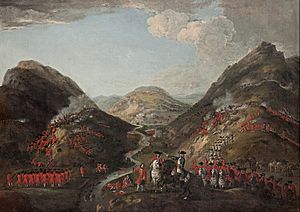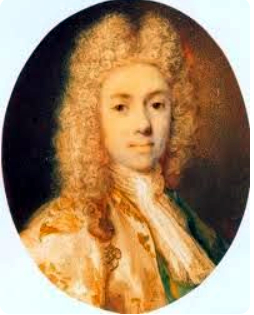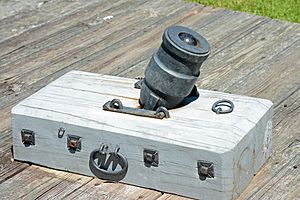Battle of Glen Shiel facts for kids
Quick facts for kids Battle of Glen Shiel |
|||||||
|---|---|---|---|---|---|---|---|
| Part of the Jacobite rising of 1719 | |||||||
 The Battle of Glenshiel 1719, Peter Tillemans |
|||||||
|
|||||||
| Belligerents | |||||||
| Commanders and leaders | |||||||
| Strength | |||||||
| 1,100 | 1,440 | ||||||
| Casualties and losses | |||||||
| 141 killed and wounded | 100 killed and wounded | ||||||
| Designated | 21 March 2011 | ||||||
| Reference no. | BTL10 | ||||||
The Battle of Glen Shiel happened on June 10, 1719, in the Scottish Highlands. It was part of the 1719 Jacobite Rising. In this battle, a Jacobite army, made up of Scottish Highlanders and Spanish soldiers, fought against British troops. The British side also had help from a special Highland company.
The Jacobite Rising was supported by Spain, which was fighting Britain in the War of the Quadruple Alliance (1718-1720). The main plan was for Spanish troops to land in England. However, this plan was cancelled weeks before the battle. People at the time thought this failure badly hurt the Jacobite cause.
Glen Shiel was different from other Jacobite Risings (1688-1746). Usually, the Jacobites would charge at their enemies. But at Glen Shiel, they stayed in a defensive position. The place where the battle happened is now a protected historic site in Scotland. A nearby mountain peak is even called 'Peak of the Spaniards' to remember the Spanish soldiers.
Contents
Why Did the Battle Happen?
Spain's Goals and the Jacobites
After a big war in 1713, Spain lost some of its lands in Italy. The Spanish leader, Giulio Alberoni, wanted to get these lands back. Spain took over Sardinia in 1717. But when they landed in Sicily in 1718, the British Navy destroyed the Spanish fleet. This started a new conflict called the War of the Quadruple Alliance.
To make Britain focus less on the Mediterranean Sea, Alberoni came up with a plan. He wanted 7,000 Spanish soldiers to land in England. Their goal was to march to London and bring back James Francis Edward Stuart as king. Many historians wonder if this plan was ever serious. Alberoni knew how hard it was to move so many troops by sea. The British Navy was very strong, as seen at the Battle of Cape Passaro.
The Spanish fleet left Spain in March but was hit by a terrible storm. It had to turn back and never reached England.
The Scottish Uprising Plan
Part of Alberoni's plan was also a rebellion in Scotland. The idea was to capture Inverness. This would allow Swedish soldiers to land and help. Sweden's king, Charles XII of Sweden, had problems with George I, who was also the ruler of Hanover.
However, King Charles XII died in November 1718. This ended any hope of help from Sweden. It also took away the main reason for the Scottish uprising.

In the end, only two Spanish ships reached Stornoway in the Isle of Lewis. They carried George Keith and 300 Spanish soldiers. Other Jacobite leaders, like the Earl of Seaforth and the Marquess of Tullibardine, joined them.
On April 13, they found out that the main plan to invade England had failed. Tullibardine, who was in charge of the Jacobite land forces, wanted to retreat. But Keith stopped this by sending the two ships back to Spain.
With no other choice, the Jacobite army, about 1,000 Highlanders and the Spanish troops, decided to march towards Inverness. They left their extra supplies at Eilean Donan Castle. Forty Spanish soldiers guarded the castle.
On May 10, a British naval group captured Eilean Donan Castle. This blocked any escape by sea for the Jacobites. Meanwhile, British General Joseph Wightman led about 1,000 men with four special mortars towards Glen Shiel. By June 9, they were less than 8 miles (13 km) from the Jacobite camp.
The Battle Begins
The Jacobite leader, Tullibardine, chose a strong defensive spot near the Five Sisters hills. He placed the Spanish soldiers in the middle. The Highlanders were on the sides, protected by trenches and barricades.
General Wightman's British forces arrived around 4:00 pm on June 10. They started their attack an hour later. They used their mortars to fire at the Jacobite positions on the sides. These mortars didn't cause many deaths, but the Scottish Highlanders had never seen them before. This surprise allowed British soldiers to move up the hill. They used grenades to force the Highlanders out of their positions.
Once the Jacobite right side was pushed back, the British attacked the Jacobite left. This side was led by Lord Seaforth. It was well-protected behind rocks on the hillside. But the clever use of mortars forced Seaforth's men to retreat. Lord Seaforth himself was badly wounded.
The Spanish soldiers in the middle, led by Colonel Nicolas de Castro Bolano, fought bravely. But as their sides gave way, they had to move further up the mountain.
The battle lasted until 9:00 pm. Some stories say the dry heather caught fire. The smoke and fading light helped most of the Scottish soldiers disappear into the night. The Spanish soldiers surrendered the next morning. As regular troops, they were later sent back home. The Jacobite leaders, including Lord George Murray, Seaforth, and Tullibardine, were wounded but also managed to escape.
Historians believe Wightman won because he used mortars well. His grenadiers had strong firepower, and his infantry fought very aggressively.
What Happened After the Battle?
It was hard to count how many Jacobites were hurt or killed. Few bodies were left on the field, and the wounded escaped. General Wightman's forces lost 21 killed and 120 wounded.
Lord Carpenter, the British commander in Scotland, told London not to chase the rebels. He believed letting them go was best, as the Rising had already hurt the Jacobite cause. Tullibardine agreed, writing that the battle "bid fair to ruin the King's Interest."
In October 1719, a British naval group captured the Spanish port of Vigo. They held it for ten days, destroying many supplies. This showed Spain how powerful the British Navy was. This event led to Alberoni losing his job and ended Spain's support for the Jacobites.
Many important Jacobites, like Bolingbroke, Seaforth, and Lord George Murray, were allowed to return home. Others joined armies in different countries. James Keith became a general in Prussia. He died in battle in 1758. George Keith became a diplomat for Prussia. He refused to join the 1745 Rising.
Tullibardine stayed in exile. He took part in the 1745 Rising and died in the Tower of London in 1746. Lord George Murray was a senior commander for Prince Charles. He died in the Dutch Republic in 1760.
Protecting the Battlefield
The area known as 'Spanish Hill' is now owned by the National Trust for Scotland. The stone walls built by the Jacobites on the northern slope are rare examples of old battle defenses in Britain. They are now a protected historic site.
Before the 300th anniversary of the battle, the National Trust for Scotland did an archaeological study of the site. They found ammunition from the mortars used against the Jacobite forces.
See also
 In Spanish: Batalla de Glenshiel para niños
In Spanish: Batalla de Glenshiel para niños
Images for kids







